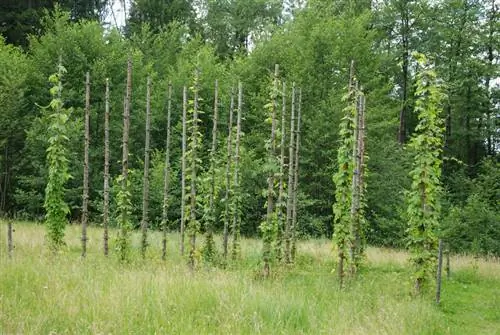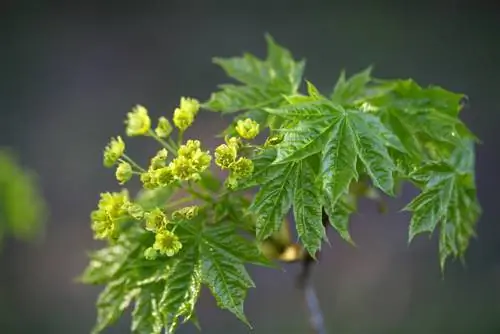- Author admin [email protected].
- Public 2023-12-16 16:46.
- Last modified 2025-01-23 11:20.
Hops is a perennial climbing plant that grows very large and develops many shoots. If you want to harvest hops, you must thin out the plant. Otherwise the fruits remain very small and contain only a small amount of valuable lupiline. How to cut hops correctly.

How do you cut hops correctly?
To prune hops properly, you should prune the plant once a year, either in fall or February. After new growth, you should thin out the shoots and leave only four to six hop tendrils on the plant.
Cut back hops once a year
- Cut hops once a year
- either in autumn or February
- thin out the plant after new growth
Basically, you only have to cut back hops completely once a year.
However, you cannot avoid thinning out after new growth. Hop plants form countless sprouts that rob each other of light and nutrients.
The best time to cut hops
Opinions differ on the question of the best time to cut back hops. Some experts cut hops as early as fall. Others wait until early spring to prune.
There is a lot to be said for pruning in February. Hops shrink towards autumn and then become brown and unsightly. The nutrients contained in the dried plant move into the roots.
If the brown stems are too unsightly for you, shorten the hops to 50 to 60 centimeters in autumn and only cut them down to the ground in February.
Leave only a few tendrils on the plant
As soon as the hops sprout again in spring, thin them out. Cut off all but four to six hop tendrils. Then the plant can develop properly and produce lots of fruits in autumn.
The cut sprouts are edible and can be used in the kitchen to make delicious dishes. They are prepared in the same way as the popular asparagus.
You can also use the sprouts to propagate hops. Stick them into prepared pots or directly into the garden soil. Even if you store them in a jar of water, roots will develop so you can plant the sprouts later.
Tip
If you want to grow an opaque privacy screen from hops, leave all shoots on the plant. This makes it nice and tight. In addition, the hops do not grow as quickly and remain significantly lower at three to five meters.






